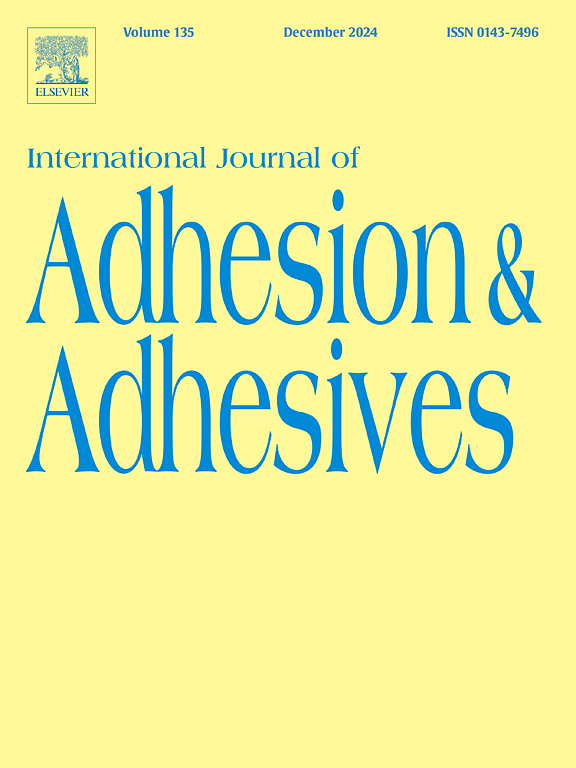Molecular mechanisms of cytotoxicity in Saos-2 osteoblast-like cells exposed to universal dental adhesives
IF 3.5
3区 材料科学
Q2 ENGINEERING, CHEMICAL
International Journal of Adhesion and Adhesives
Pub Date : 2025-07-15
DOI:10.1016/j.ijadhadh.2025.104101
引用次数: 0
Abstract
Statement of the problem
Universal adhesives have gained popularity simplifying dental restorative procedures. However, limited information exists regarding formulation variations among manufacturers and their impact on cytocompatibility using human-derived cell lines.
Purpose
This study aimed to investigate the molecular mechanisms of cytotoxicity of three universal adhesives-Ambar Universal (AU), Single Bond Universal (SB), and Prime & Bond Universal (PB)-on human-derived Saos-2 osteoblast-like cells, elucidating the differential induction of apoptosis and necrosis pathways, contributing to a greater understanding of their biological effects.
Methods
Saos-2 cells were incubated with 0.1 % v/v AU, SB, or PB during 2, 4, or 6. h. Populations of viable, early apoptotic, late apoptotic, and necrotic cells were estimated by cell sorting after Annexin V/Propidium Iodide staining. Apoptosis indicators, caspase-3 activation or nuclei fragmentation were addressed by immunoblot or immunofluorescence, respectively. Cytotoxicity was evaluated after 24 h incubation, using MTT Cell Proliferation Assay, with or without the apoptosis inhibitor Z-VAD-FMK.
Results
SB exhibited a higher percentage of early apoptotic cells, and a significant increase in activated caspase-3 compared to control. AU and PB significantly increased necrosis, reducing cell viability by 100 %, compared to a 52 % reduction with SB. Immunofluorescence showed apoptotic nuclei morphology for SB, and necrotic characteristics for AU and PB. The apoptosis inhibitor Z-VAD-FMK only abolished SB-evoked cytotoxicity.
Conclusion
The universal adhesives studied induced cell death in Saos-2 cells through different mechanisms. SB primarily evoked apoptosis, whereas AU and PB predominantly led to necrosis. These varying cytotoxic effects should be considered when selecting safer universal adhesives for clinical use. However, these findings should be interpreted with caution, as the exclusive use of the Saos-2 osteosarcoma cell line may not fully reflect the biological behavior of dental pulp cells or other oral tissues.
通用牙胶粘剂对Saos-2成骨细胞细胞毒性的分子机制
万能粘接剂的普及简化了牙齿修复程序。然而,关于生产商之间的配方差异及其对使用人类来源细胞系的细胞相容性的影响的信息有限。目的探讨三种通用胶粘剂ambar universal (AU)、Single Bond universal (SB)和Prime &的细胞毒性分子机制;Bond Universal (PB)对人源性Saos-2成骨细胞样细胞的影响,阐明了凋亡和坏死途径的差异诱导,有助于更好地了解其生物学效应。方法将saos -2细胞分别用0.1% v/v AU、SB或PB孵育2、4、6天。h.膜联蛋白V/碘化丙啶染色后,通过细胞分选估计存活细胞、早期凋亡细胞、晚期凋亡细胞和坏死细胞的数量。细胞凋亡指标、caspase-3活化和细胞核破碎分别通过免疫印迹和免疫荧光检测。使用或不使用凋亡抑制剂Z-VAD-FMK,在孵育24小时后使用MTT细胞增殖试验评估细胞毒性。结果与对照组相比,ssb组早期凋亡细胞比例较高,活化caspase-3显著增加。AU和PB显著增加了坏死,使细胞活力降低了100%,而SB则降低了52%。免疫荧光显示SB的细胞核凋亡形态,AU和PB的细胞核坏死特征。凋亡抑制剂Z-VAD-FMK仅能消除sb引起的细胞毒性。结论通用黏合剂通过不同机制诱导Saos-2细胞死亡。SB主要引起细胞凋亡,而AU和PB主要引起坏死。在选择更安全的通用胶粘剂用于临床使用时,应考虑这些不同的细胞毒性作用。然而,这些发现应该谨慎解释,因为单独使用Saos-2骨肉瘤细胞系可能不能完全反映牙髓细胞或其他口腔组织的生物学行为。
本文章由计算机程序翻译,如有差异,请以英文原文为准。
求助全文
约1分钟内获得全文
求助全文
来源期刊

International Journal of Adhesion and Adhesives
工程技术-材料科学:综合
CiteScore
6.90
自引率
8.80%
发文量
200
审稿时长
8.3 months
期刊介绍:
The International Journal of Adhesion and Adhesives draws together the many aspects of the science and technology of adhesive materials, from fundamental research and development work to industrial applications. Subject areas covered include: interfacial interactions, surface chemistry, methods of testing, accumulation of test data on physical and mechanical properties, environmental effects, new adhesive materials, sealants, design of bonded joints, and manufacturing technology.
 求助内容:
求助内容: 应助结果提醒方式:
应助结果提醒方式:


